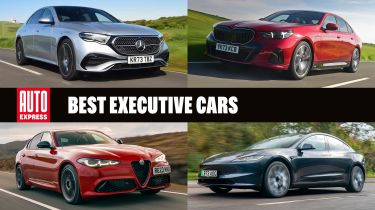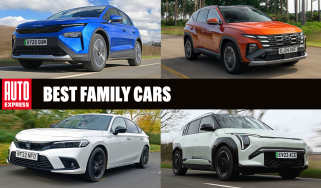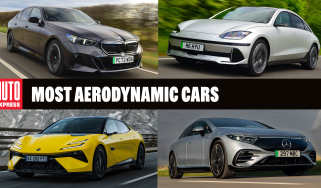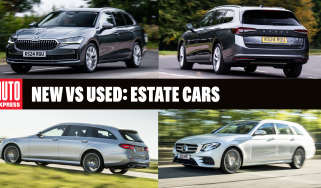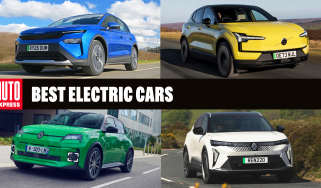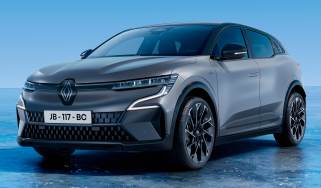Best executive cars to buy 2025
These executive cars add a real touch of class to every journey
If you’re looking to buy an executive car you’ll quickly find yourself in a sea of prestigious, premium-badged models, typically in saloon or four-door hatchback body styles. The best executive cars have that all-important badge prestige in abundance but they also offer levels of long distance comfort, performance and technology that are a cut above the rest.
Executive cars are often chosen as company cars so a plug-in hybrid or pure-electric powertrain is highly desirable for BiK company car tax reasons but also for the refinement and effortless pace it can deliver. There’s still a lot of appeal in the traditional petrol engine, which tends to be the more affordable choice these days but diesel options are less common in this sector and the car market as a whole.
To help narrow down your search, we’ve compiled this list of the best executive cars you can buy right now, based on our extensive testing of every new model on sale. Read on to find our top-10 executive cars.
1. BMW 5 Series
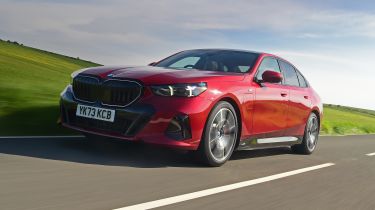
At a glance
Engine power
208 - 489 BHP
0 - 62mph
4.3 - 7.8 secs
Top Speed
137 - 155 MPH
Fuel Economy
45.6 - 48.7 MPG
Insurance Group
34E - 45E
Whether you opt for the regular BMW 5 Series or the fully electric BMW i5, the latest generation of this full-size executive saloon offers the same class-leading tech, excellent driving experience and top-shelf fit and finish that have made it a staple of the executive car class for decades.
Step inside the 5 Series and the cabin doesn’t feel too dissimilar to the pricier and more luxurious BMW 7 Series flagship. There are plenty of plush, comfortable materials and these are accompanied by a 12.3-inch digital driver’s display and a 14.9-inch widescreen infotainment system that operates BMW’s iDrive software. Unfortunately, the touch-sensitive controls cause the usual frustrations, but these are soon forgotten because the BMW 5 Series is highly enjoyable to drive. There’s even room for all the family, thanks to its spacious cabin and 520-litre boot.
2. BMW 3 Series
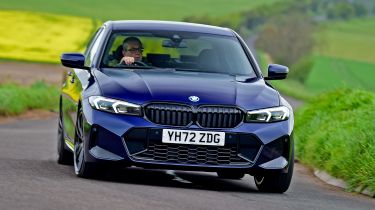
At a glance
Engine power
184 - 374 BHP
0 - 62mph
4.4 - 7.6 secs
Top Speed
143 - 155 MPH
Fuel Economy
34.9 - 42.8 MPG
Insurance Group
28E - 39E
BMW takes a one-two in this list because the 3 Series pretty much offers the same attributes as its bigger 5 Series sibling. The driving dynamics are arguably better, there’s still an excellent, premium-feeling interior with plenty of technology and the Touring estate model should be practical enough for most families.
The 3 Series has long been the default compact executive-car choice for those seeking a sporty drive, and the latest version builds on this by reducing weight by up to 55kg and increasing rigidity by up to 50 per cent. Despite being larger than its predecessor, the latest 3 Series is even more agile and nimble in the bends. Ride comfort only loses out to the Mercedes C-Class, but the BMW’s specially developed damper technology means long drives are no chore.
3. Mercedes E-Class

At a glance
Engine power
197 - 367 BHP
0 - 62mph
4.8 - 7.6 secs
Top Speed
146 - 155 MPH
Fuel Economy
40.9 - 58.9 MPG
Insurance Group
41E - 50E
The latest Mercedes E-Class had big shoes to fill when it arrived in 2023. Not only is it the latest generation of a long line of E-Classes, but we were particular fans of the outgoing model. Thankfully, the W214 is one of the brand’s best cars to date.
Take a seat inside and you’ll immediately notice the Superscreen dashboard. This consists of a 12.3-inch digital instrument panel and a 14.4-inch central display – a 12.3-inch passenger screen is also available as an option. These run the latest MBUX software and operate a plethora of functions, including voice-activation, massaging seats, mood lighting and even a cabin camera that can be used to take selfies. The technology is plentiful, and the materials and build quality more than match it.
On the move the ride is especially smooth if you choose the optional air suspension. Although the Mercedes can’t quite match the dynamic nature of the BMW 5 Series, it still maintains its composure well in corners. This generation is also the largest E-Class yet, with most of its added bulk being used to increase cabin space. This means that five passengers will fit with ease and, with 540 litres of boot space, it can even double up as a family car.
4. Tesla Model 3
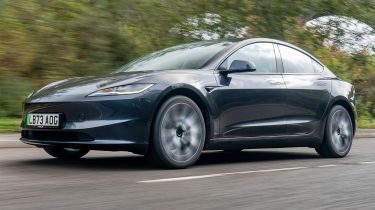
At a glance
Power
245 - 460 BHP
0 - 62mph
2.9 - 5.8 secs
Top Speed
125 - 163 MPH
Efficiency
4.4 - 5 m/kWh
Range
328 - 436 miles
Insurance Group
36D - 48D
The Tesla Model 3 has been with us for a while now but, thanks to a midlife facelift, it’s still one of the best electric cars to buy. With up to 390 miles of battery range on tap, the Model 3 should quell any anxiety around charging, and every variant offers enough performance punch to surprise many focused sports cars. The flagship Performance variant shoots from 0-60mph in an incredible 2.9 seconds, yet it still offers up to 328 miles between charges. It’s not just acceleration and range where the Model 3 excels, though, because the quietness of the electric motor and relatively well judged damping make for a pleasant ride.
The cabin is futuristically minimalist and an alternative approach to the clutter of having dozens of buttons, although some people might call it dull. There’s plenty of space inside, with generous headroom in both the front and rear. The big windows also help to make the cabin feel airy.
5. BMW i4
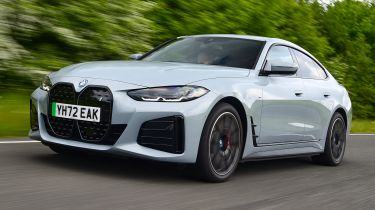
At a glance
Power
286 - 544 BHP
0 - 62mph
3.9 - 6 secs
Top Speed
118 - 140 MPH
Efficiency
3.5 - 4 m/kWh
Range
287.7 - 366 miles
Insurance Group
34E - 44E
The BMW i4 is still one of the Tesla Model 3’s fiercest competitors in the growing electric executive car market. Pricing for the i4 starts from less than £52,000 for the entry-level eDrive35, yet this model still provides up to 308 miles of range, along with a reasonable 282bhp – meaning 0-62mph is dealt with in six seconds. If speed is what you seek, the i4 M50 ups the power to 537bhp and will easily keep up with most performance cars (electric or otherwise), thanks to a 0-62mph time of just 3.9 seconds.
It’s not all about the performance, though, because the i4’s technology is bang up to date, with BMW’s latest iDrive infotainment system being the centrepiece. This is operated through a large, seamless display that combines a 12.3-inch digital instrument panel and a 14.9 inch central screen. The i4 is well put-together, too, and while it has a sportier feel than some rivals, it should still prove comfortable on longer journeys.
6. Mercedes C-Class
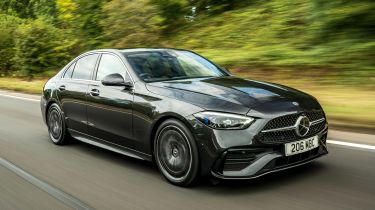
At a glance
Engine power
197 - 680 BHP
0 - 62mph
3.4 - 7.5 secs
Top Speed
149 - 168 MPH
Fuel Economy
30.1 - 62.8 MPG
Insurance Group
33E - 50E
The latest Mercedes C-Class is the best version of this compact executive car that we’ve seen for decades. The C-Class has always been known as one of the more comfortable offerings in its segment, and this new one uses a smaller version of the MRA architecture that underpins the flagship Mercedes S-Class.
This translates into a superb ride that can rival far more prestigious cars. Couple this with the plush, tech-filled interior and the C-Class is an excellent car to rack up the miles in. Choose the plug-in hybrid C 300 e and you can even cover up to 70 miles on pure-electric power.
7. Volkswagen ID.7
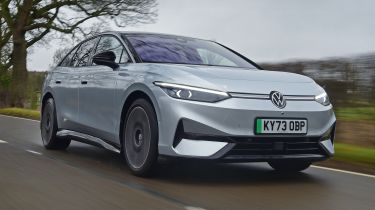
At a glance
Power
286 - 340 BHP
0 - 62mph
5.4 - 6.6 secs
Top Speed
112 MPH
Efficiency
3.8 - 4.5 m/kWh
Range
364 - 434 miles
Insurance Group
38E - 41E
As the electric executive car sector continues to expand, Volkswagen has finally thrown its hat into the ring with the ID.7. Available as either a saloon or an estate car, we think the ID.7 is VW’s best EV to date, and it offers plenty of refinement and practicality, along with a whopping 437-mile claimed battery range in the Pro S variant.
Unfortunately, a starting price that sits firmly north of the £50,000 mark means this isn’t really a “people’s car”, but the VW ID.7 certainly feels upmarket enough to sit in this bracket. There’s plenty of kit included across the line-up, although we do wish that the heat pump wasn’t a £1,050 option.
8. Porsche Panamera
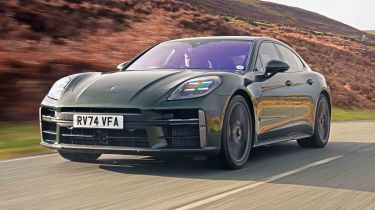
At a glance
Engine power
353 - 782 BHP
0 - 62mph
2.9 - 5.3 secs
Top Speed
168 - 202 MPH
Insurance Group
46E - 50E
If you fancy a sports car but need something that’s a bit more suitable for long motorway runs and maybe even family duties, the Porsche Panamera is an ideal solution. While it’s not quite as engaging to drive as a full-fat Porsche 911, this four-door saloon still produces a minimum of 348bhp and 500Nm of torque, so it’ll still put a smile on your face when you want it to.
When it’s time to be a bit more sensible, the Panamera settles down into a calm and comfortable mile-muncher. There’s also the option of the plug-in E-hybrid model if you want to keep the Porsche’s fuel economy and emissions well under control.
9. Alfa Romeo Giulia
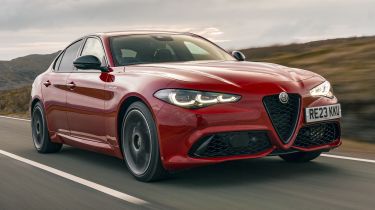
At a glance
Engine power
280 - 520 BHP
0 - 62mph
3.9 - 5.7 secs
Top Speed
149 - 191 MPH
Fuel Economy
28 - 39.2 MPG
Insurance Group
32E - 44E
If looking good ranks high on your list of priorities for an executive car, the Alfa Romeo Giulia should be near the top of the pile. That said, the Giulia is no disappointment when it comes to running costs and refinement either. If you’re buying brand-new, the only option is a 276bhp four-cylinder petrol engine – which is certainly peppy enough to have fun with the rear-wheel drive set-up. Of course, there’s always the Alfa Romeo Giulia Quadrifoglio if you really have a need for speed.
The interior is a great improvement over Alfa saloons of old, too, with good-quality materials and slick design helping to give an upmarket appeal – even if it falls just shy of the Mercedes C-Class. Where the Giulia falls down is on practicality, because there’s no estate model to challenge the BMW 3 Series Touring.
10. Audi A5
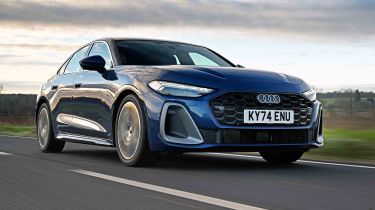
At a glance
Engine power
150 - 367 BHP
0 - 62mph
4.5 - 9.8 secs
Top Speed
132 - 155 MPH
Fuel Economy
35.8 - 57.6 MPG
Insurance Group
23E - 43E
Replacing both the old Audi A4 and A5, the new Audi A5 comes as a Sportback (saloon) or an Avant (estate). It’s bigger inside and out, with a slicker finish signalling that Audi’s smallest executive car has grown up. But so has the price.
Audi’s worked on the A5’s driving experience in an attempt to make it more engaging than before. While it’s not going to set keener drivers’ hair alight, a mix of petrol and diesel engines feeding power to the front or all four wheels offer perky performance and respectable economy. There’s enough space in the new A5 to be useful, but its boot space doesn’t quite match rivals. Its new interior is smart, with plenty of tech to play with, but it does feel as though Audis is relying a little too much on touch screens.
Best executive cars: ratings table
| Ranking for length of range | Model | Interior, design & technology rating (out of 5) | Overall Auto Express star rating (out of 5) |
| 1 | BMW 5 Series | 4 | 4.5 |
| 2 | BMW 3 Series | 4.1 | 4.5 |
| 3 | Mercedes E-Class | 4 | 4 |
| 4 | Tesla Model 3 | 4 | 4.5 |
| 5 | BMW i4 | 4.6 | 4.5 |
| 6 | Mercedes C-Class | 4.6 | 4 |
| 7 | Volkswagen ID.7 | 3.8 | 4 |
| 8 | Porsche Panamera | 4.7 | 4 |
| 9 | Alfa Romeo Giulia | 4.2 | 4 |
| 10 | Audi A5 | 4.5 | 4 |
What is an executive car?
This was once a very straightforward question to answer. You had your executive saloons, such as the BMW 5 Series and Mercedes E-Class, then you had your compact executive saloons, such as the BMW 3 Series. Today, the variety of options has multiplied.
Cars such as the Peugeot 508 and Skoda Superb all have aspirations of upsetting traditional executive car offerings such as the Mercedes E-Class and BMW 5 Series. The best of these models offer most of the necessary quality and tech, and only really lack the premium badge.
Even without dipping into the SUV class, where executive-car buyers will increasingly find tempting options, there are more body styles available to executive-car drivers than ever. As well as the traditional saloons, there are the usual estate versions on offer, and beyond that things start to get interesting.
Two-door coupés such as the BMW 4 Series offer similar engine ranges to their saloon counterparts for similar tax and running costs, while looking and driving that bit sharper. Many also come in convertible guise for open-air motoring. Then there's the rise of the four or five-door coupé, typified by cars such as the Audi A7 Sportback and BMW 4 Series Gran Coupé.
The usual cohort of German executive-car manufacturers now has plenty of other challengers to face, especially the incoming wave of pure-electric models that qualify for executive-car status, such as the Tesla Model 3.
With the executive-car market so strongly reliant on business and company car buyers, EV powertrains are a huge draw because of the lower associated Benefit-in-Kind company car tax. Diesel and petrol powertrains are still popular for private buyers, but plug-in hybrid and electric sales are starting to really gain momentum. If you're willing to take the plunge into EV territory, the BMW i4, Polestar 2 and Tesla Model 3 offer sports car-rivalling straight-line performance, acres of space and very low everyday running costs.
How you can choose the best executive car
There are plenty of executive cars on the market, but each has their own pros and cons to consider. On this page we’ve picked our top executive options - covering a wide range of shapes, sizes, prices, and engines.
The demands of the market are changing, though, which means not everyone’s after an executive saloon or estate. Have a look at our guides to the best luxury or family SUVs, best long distance cars, most economical SUVs, or maybe the best electric cars, for a wider view of what’s on offer.
A top executive model will be comfortable on a long journey but still able to entertain its driver on a twisty road. When you take your test drive make sure you sample it in different types of driving because a top executive car should excel across the board.
We expect a good quantity of advanced safety equipment as standard with lots more desirable options available to those with deep enough pockets. Keep an eye on the price when adding those optional extras because they really can push the price up at this level.
Think about practicality as well because space in the back will be important if you’re regularly carrying passengers. Compact executive models like the BMW 3 Series and Mercedes C-Class will not have the same roomy back seats you get in full executive models like the larger 5 Series or E-Class. With many executive cars still employing the saloon bodystyle, the boot space can be quite low and long. If you need more flexible carrying capacity, one of the five-door hatchback options could suit.
Let’s look at the basics of what you need to consider when buying an SUV today with some FAQs...
With the executive-car market so strongly reliant on business and company car buyers, EV powertrains are a huge draw because of the lower associated Benefit-in-Kind company car tax. Diesel and petrol powertrains are still popular for private buyers, but plug-in hybrid and electric sales are starting to really gain momentum. If you're willing to take the plunge into EV territory, the BMW i4, Polestar 2 and Tesla Model 3 offer sports car-rivalling straight-line performance, acres of space and very low everyday running costs.
Frequently Asked Questions
An executive car is a common name for a large, or E-segment car, and there are also compact executive models in the smaller D-segment below. They’re often bought as company cars and would suit professionals, managers, and people who like space coupled with an engaging drive, refinement, and up to the moment technology. They can be saloons, estates, coupes, or even hatchbacks.
Executive cars used to be the preserve of company car schemes alone, but today they’re available to all, and can come with all sorts of tech and engines. From frugal diesels, to powerful petrol engines - it’s not unheard of that a five-door executive car can keep pace with serious sports cars.
Searching for something a bit more special? Read our list of the best luxury cars...
